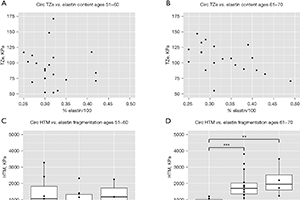Elastin integrity in bicuspid valve-associated aortopathy is associated with altered biomechanical properties and influenced by age
Abstract
Background: Aortic wall remodelling in bicuspid aortic valve (BAV) patients is heterogeneous and characterized by elastin fiber breakdown alongside impaired biomechanics. However, the relationship between aortic histopathological changes and biomechanics are incompletely understood. We clarify the influence of elastin fiber integrity on ex vivo aortic wall mechanical properties in BAV patients, and explore the influence of patient age.
Methods: Aortic tissue samples (N=66) from 19 BAV patients undergoing prophylactic ascending aortic resection surgery were analyzed. Semi-quantitative histopathological analysis was conducted to assess elastin fiber integrity including elastin content and elastic fiber fragmentation. Ex vivo biaxial mechanical testing generated stress-strain curves from which physiological [low-strain tangential modulus (LTM), transition zone onset stress (TZo)] and supraphysiological [transition zone end stress (TZe) and high-strain tangential modulus (HTM)] mechanical properties were obtained. Relationships between histopathology and mechanical properties were determined using a linear mixed effect model. BAV patients were subdivided according to ‘younger’ and ‘older’ age groups (i.e., 51–60 and 61–70 years old, respectively).
Results: No statistically significant differences in elastin content were observed between younger and older BAV patients. Older patients showed greater elastin fiber fragmentation compared to their younger cohort (74% versus 61%). Elastin fiber histopathology was associated with differences in physiological mechanical properties: elastin fragmentation corresponded with lower LTM (P=0.005) and TZo (P=0.044) in younger BAV patients and higher LTM (P=0.049) and TZo (P=0.001) in older BAV patients. Histopathology changes were significantly associated with supraphysiological mechanical properties only in older BAV patients: decreased elastin integrity was associated with increased TZe (P=0.049) and HTM (P<0.001).
Conclusions: Elastin histopathologic changes in BAV aortopathy correspond with differences in mechanical properties and this relationship is influenced by patient age. These novel findings provide additional mechanistic insights into aortic wall remodeling and support a more nuanced stratification of BAV patients by age.
Cover






